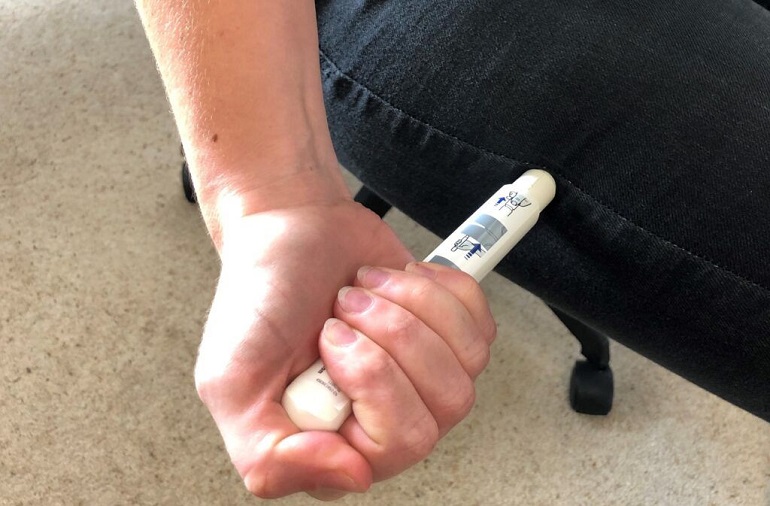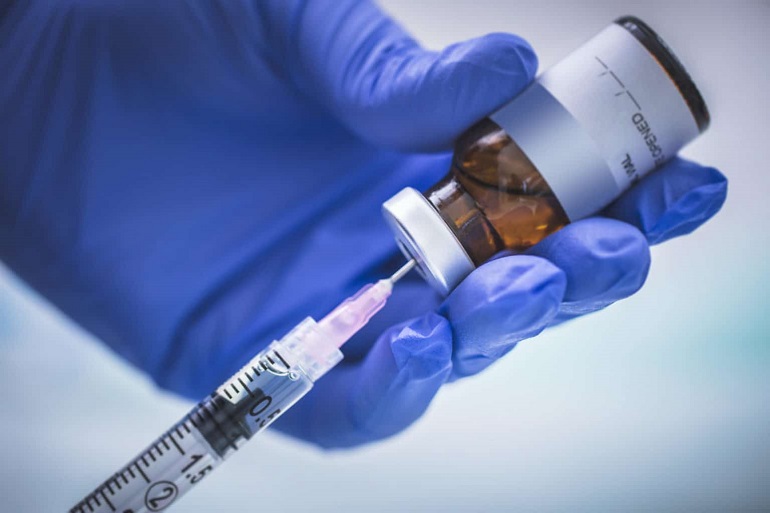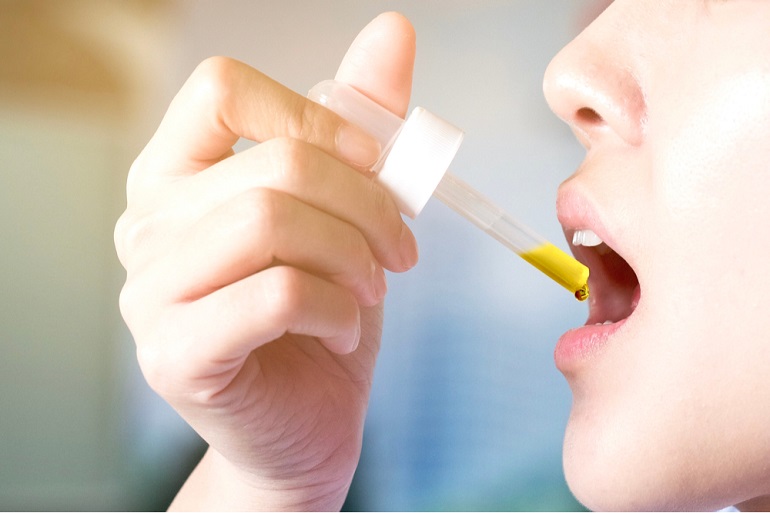Why do we have allergies is a question not yet completely answered. One cause is atopy, a genetic predisposition to produce a specific subtype of antibodies after antigen exposure, the IgE antibodies. In addition to hereditary predisposition, lifestyle factors such as a farming environment, smoking, family size, body weight, or frequency of colds significantly influence the immunoglobulin IgE antibody formation rate. Climate has been reported as an influential factor in perennial and seasonal allergies as well.
What happens when you ingest an antigen? Symptomatic reactions can range from itching and hives (wheals) to anaphylactic shock and only occur in sensitized individuals, i.e. people who have had at least one prior asymptomatic contact with the seemingly innocent culprit. This primary contact leads to the formation of the game changers in allergies, the IgE antibodies.
After being formed, IgE antibodies cover the immune cells, mast cells and basophils, other key players in the allergic process. IgE antibodies have receptors for their “initiators”, the antigens, and upon repeated contact, they cause a release of inflammatory mediators from the immune cells through a process called degranulation.
The release of inflammatory mediators can lead to itching (pruritus), hives (urticaria), swelling (edema), angioedema (edema of deeper layers of skin) rash (pruritus), rhinitis, bronchospasm or abdominal cramping. And while there is no definite cure, there are some possible treatments for allergies – from life-life savers to symptom relievers.
Adrenaline Pen

Epinephrine pens are literally life savers. Designed as an auto-injector, you can deliver 300mcg with an intramuscular adrenaline injection if the worst-case scenario starts unfolding i.e. anaphylaxis. It’s definitely a smart thing to have in your first aid kit.
Anaphylaxis is an acute, potentially life-threatening generalized release of the same inflammatory mediators mentioned above. In this case, the overexaggerated response in addition to the rash, angioedema, vomiting, and diarrhoea can also cause abnormal breathing sounds (stridor), difficulty breathing (dyspnea), bronchospasm and even circulatory failure. Rapid recognition and treatment are key to prevent death from respiratory or cardiovascular failure.
The most common triggers of anaphylaxis in kids are food allergies (peanut, tree nuts) and insect (bee) stings while the main concerns in the elderly population are drug and radiocontrast allergies. Patients with known serious allergic reactions to food or insect venom, for example, should always be provided with antihistamines, corticosteroids, and an adrenaline pen for emergency self-medication.
You can even purchase a training pen so you and your children can practice adrenaline self-administration and rest assured that the whole family is prepared for an allergic emergency.
Oral Antihistamines and Glucocorticoids

Antihistamines are drugs that block histamine receptors (H1 and H2 receptors) that are found in the smooth muscle cells in the bronchial and nasopharyngeal tissues, vascular endothelial cells, central nervous system and heart. H1 antihistamines are mostly used to treat allergic reactions and mast cell-mediated disorders, with the second-generation H1 antihistamines (loratadine, desloratadine, cetirizine, levocetirizine) being the favourites due to their milder sedative effect. In case of a mild allergic reaction, besides elimination of the offending agent, antihistamines are the first choice of treatment.
Glucocorticoids are drugs that are structurally and functionally similar to our bodies’ own glucocorticoid hormone cortisol. Their anti-inflammatory and immunosuppressive effects are caused by binding to glucocorticoid receptors, which causes complex changes in gene transcription and subsequential protein formation. Moderate reactions should be treated with the withdrawal of the offending drug and antihistamines ± glucocorticoids.
Common examples include hydrocortisone, prednisone, prednisolone, methylprednisolone. Due to their multiple effects, glucocorticoids are a double-edged sword hence they should be used with extreme caution.
Allergen Immunotherapy

Allergen immunotherapy (desensitization) is a procedure in which doctors apply a very small (subclinical) dose of the antigen, enough to cause your immune system to “wake up and react” but not overreact.
Allergen immunotherapy is recommended for people who have a previously well-documented history of allergy, with significant symptoms despite symptomatic therapy and avoidance of the allergen. By the careful and measured introduction of the allergens to the body, we are giving it a chance to adapt to the antigen and “switch” its IgE antibodies to less harmful ones.
Although the duration of the treatment is at least 3 years, success is seen in up to ⅔ of the patients. Younger patients show more promising results.
Alternative Allergy Treatments

Traditional Chinese medicine is the main component of complementary and alternative medicine (CAM). CAM practices in the treatment of allergy/immunology are also increasing. Acupuncture has been reported to reduce wheal (hives) size, skin itching following allergen skin tests and basophil activation. Moreover, a number of clinical trials of acupuncture on allergic rhinitis have been carried out in Australia.
In a survey by the American Academy of Allergy, Asthma, and Immunology (AAAAI) in 2009, 80% of the allergy specialists were interested in learning about CAM. In 2016, many reports were made on patients using herbal medicines, vitamins, probiotics, fish oil, acupuncture, yoga, meditation and deep breathing.
The most common indications for CAM use were allergic rhinitis, asthma, eczema, food allergy, overall health and well-being and allergy prevention. The use of CAM remedies for food allergy had increased from 11% in 2002 to 18% in 2006.
How Can We Prevent Allergies?
Avoid Common Allergens

Sorry to disappoint if you’re a big cheese fan and always follow the latest trends but dairy allergy is much more common than you think. In fact, the most common food allergens are cow’s milk, eggs, nuts, peanuts, seafood (e.g., shellfish, fish), soy, wheat, fruits (e.g., kiwi). Contact prevention and avoidance of offending agents are and probably always will be the best treatment for allergies.
Individuals with allergies may also react to substances that contain particles that are similar to the main antigen, a phenomenon called cross-reactivity. For example, your pollen allergy might be activated by eating an apple, hazelnut, carrot or kiwi while if you are allergic to birds, your anti-bird dander IgE antibody could cross-react with an egg yolk.
Anti-Allergy Diet Plan & Diary

In addition to all the foods you should avoid, there are certain foods that can help you in your fight against allergies. Best of all, you won’t have to wait for your special magic herb to arrive from halfway across the world. The best and simplest remedies can be found in the local supermarket or even be homegrown.
Try ginger, tomatoes, citrus fruits and other vitamin C rich foods to decrease allergic rhinitis symptoms. There have been animal studies on the effects of turmeric and bee pollen on their anti-inflammatory effects. Although no human studies exist so far, results from animal studies look rather promising.
Track what you consume in a food diary so you can find a connection between your symptoms and the foods you are ingesting. Discipline and organization can boost your immune system more than you can even imagine.

